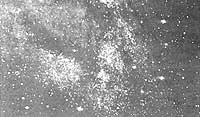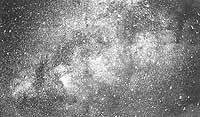The Darkness of Heaven: Olbers' Paradox
1988/04/01 Arregi Bengoa, Jesus Iturria: Elhuyar aldizkaria
On this occasion the problem we are going to analyze does not seem (after the first reading) as deep as it happens later. As we will see, to reach the resolution we have to mention the big-bang of the Universe. Let's see what the problem is.
When we talk about the darkness of heaven, we don't just want to talk about the darkness of the night. We go much further. The argument was first raised by Kepler to demonstrate that the Universe could not be infinite and homogeneous. If, according to German astronomers, the Universe was infinite and homogeneous, from anywhere, we would find some star. Since the most common stars are similar to the Sun, we would receive an irradiation similar to the one we receive from the Sun at all points of the sky. This would mean the disappearance of the night, with the light of all day forever.

We can put an object to the said remembering that the intensity of the light received (I) is proportional to the square of the distance to the focus (I>1/r 2). However, the increase in the number of stars that the distance implies causes an opposite effect, without diminishing the luminosity. Let us think that the Universe is divided into thin spherical layers centered on the Earth. The surfaces of these spheres are proportional to the square of the radius (A = 4 r 2). Therefore, the number of stars and therefore the luminosity will increase in the same way. This is the reason why the clarity we would receive everywhere is the same. After these necessary explanations of the title, let us explain the paradox.
Olbers was the first to attempt to answer the question without resorting to the finitude of the Universe. Olbers accepted Kepler's argument, but believed that the light, interstellar gas and dust he absorbed on the road did not reach us. However, reasoning is not entirely correct. According to Herschel later, the gases and powders would be heated soon and, once the thermal balance was reached, as many lights would be reemitted as received, giving the sky the aforementioned luminosity.
These debates took place in the second quarter of the last century. At that time it was not easy to find an explanation because reasoning has to take into account two things: the finite speed of light and the expansion of the Universe. The first began to be considered after the publication of the experiments of Fizeau and Foucault in the second half of the last century, although Roemer measured the speed of light in 1675. However, the expansion of the universe was discovered in 1920 and it would certainly be too brave to consider it as a hypothesis at the time when Olbers discussed the paradox. But let's see how the problem can be explained taking into account these two points.
The expansion of the universe has two consequences in this problem that concerns us. As the universe expands, galaxies and stars move away from each other, except for local irregularities. Therefore, due to the Doppler effect, the emissions we receive present a redshift, that is, they are less energetic. The higher the speed of distance (which increases with distance), the greater the loss of energy, but the loss is not enough to undo the paradox.
The second effect is total. Considering the distribution of stars seen in the universe, to see the illuminated sky as described at first we would need the light of the stars that would be found in a sphere of 10 23 light years of radio. As is known, the expansion is due to the big-bang explosion that created the Universe. The date of the explosion is already limited: 15 billion years ago (15.10 9 years). The conclusion that can be drawn is evident: Stars over 10 9 light years have not yet had time to arrive.
Therefore, the light we receive today, which has been able to reach at that time, is that of the stars found in a radius sphere of 10 9 light years. The volume of this sphere is 4/3 10 27. But the light we need is what the stars of the sphere would provide us with a radius of 10 23 light years. The volume of this second sphere is 4/3 10 69. While the comparison is not entirely correct because other factors must be taken into account, we can observe the small proportion of light needed when comparing these volumes. This is the deep reason for the darkness of heaven.

Gai honi buruzko eduki gehiago
Elhuyarrek garatutako teknologia





